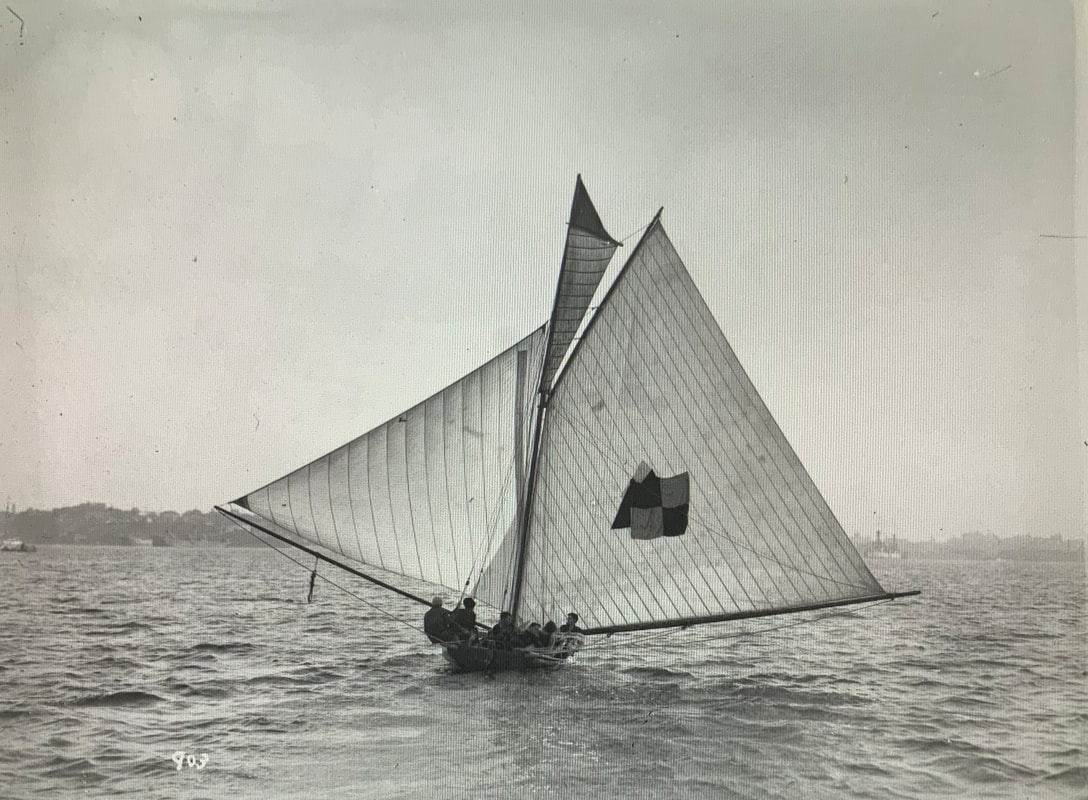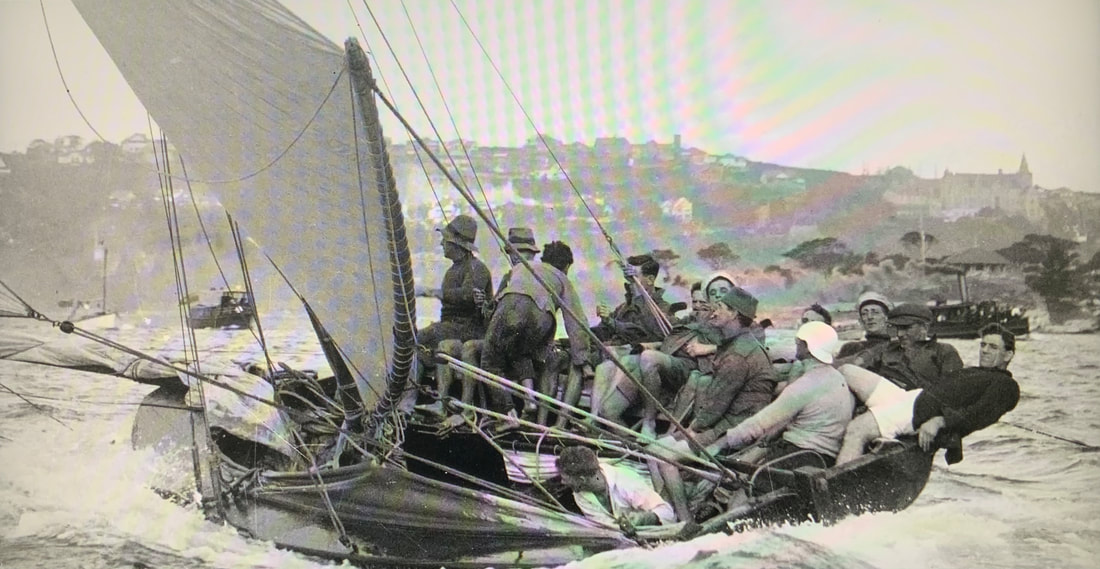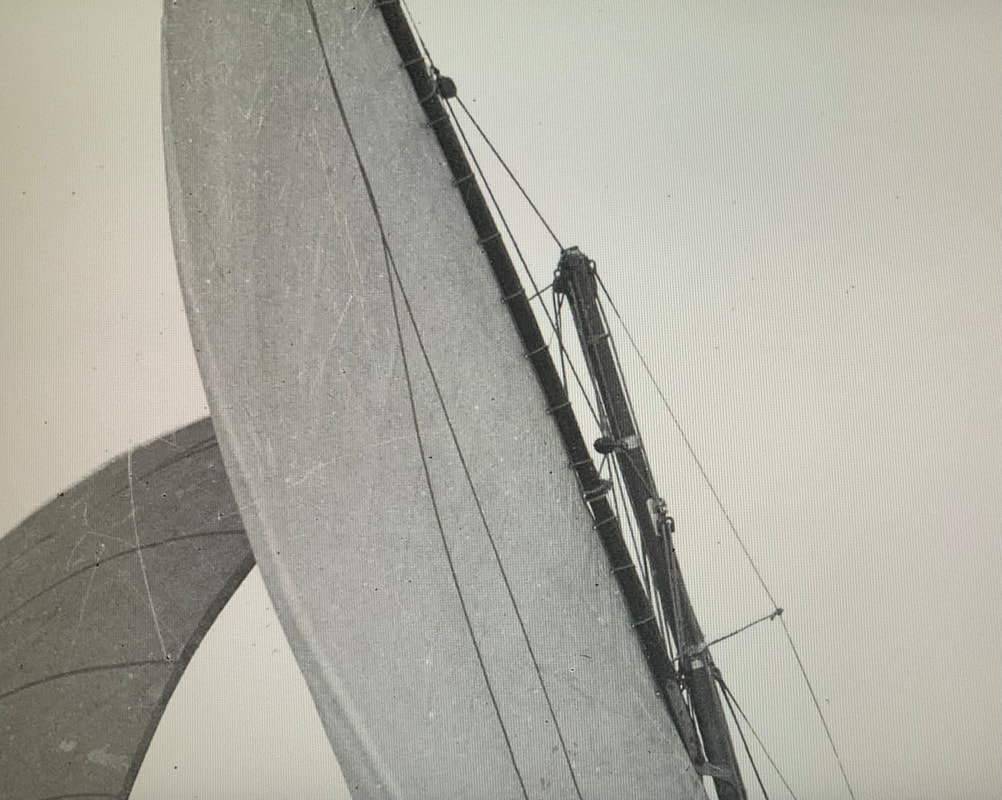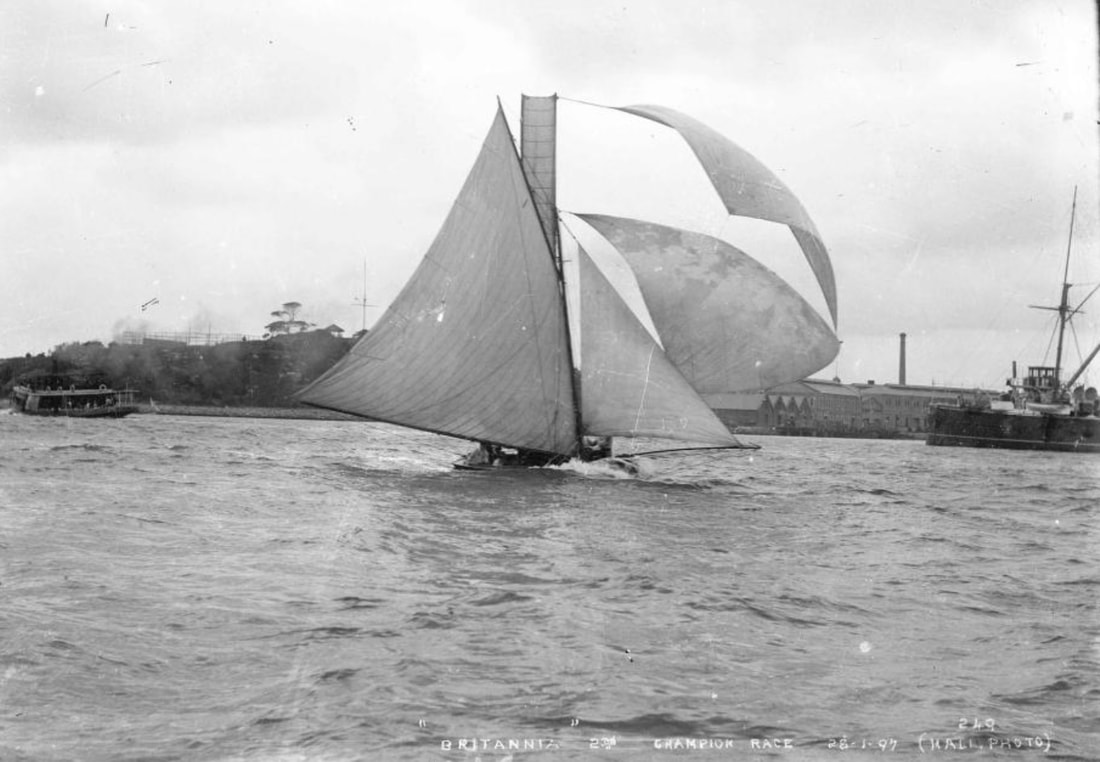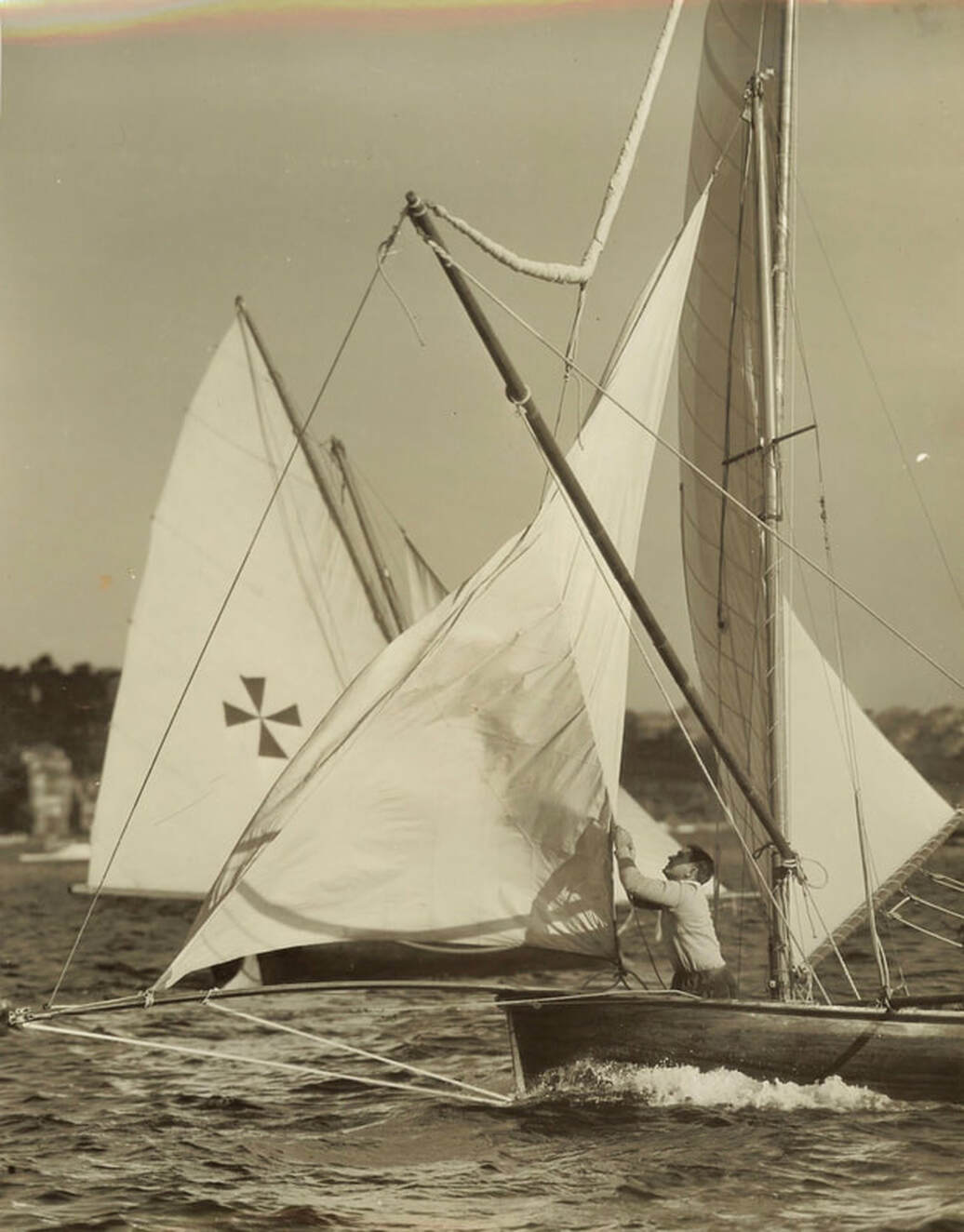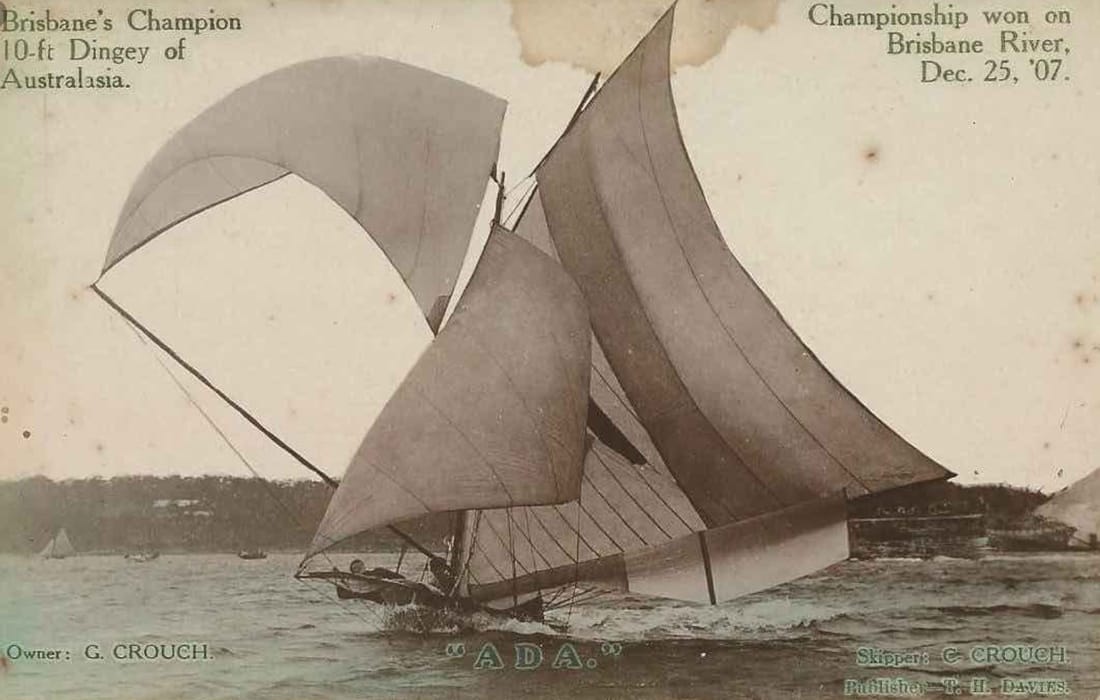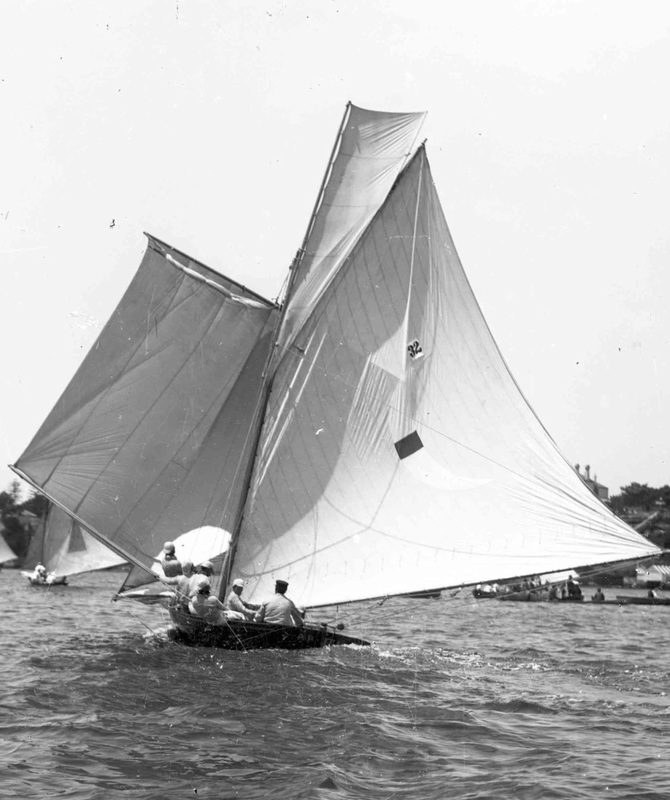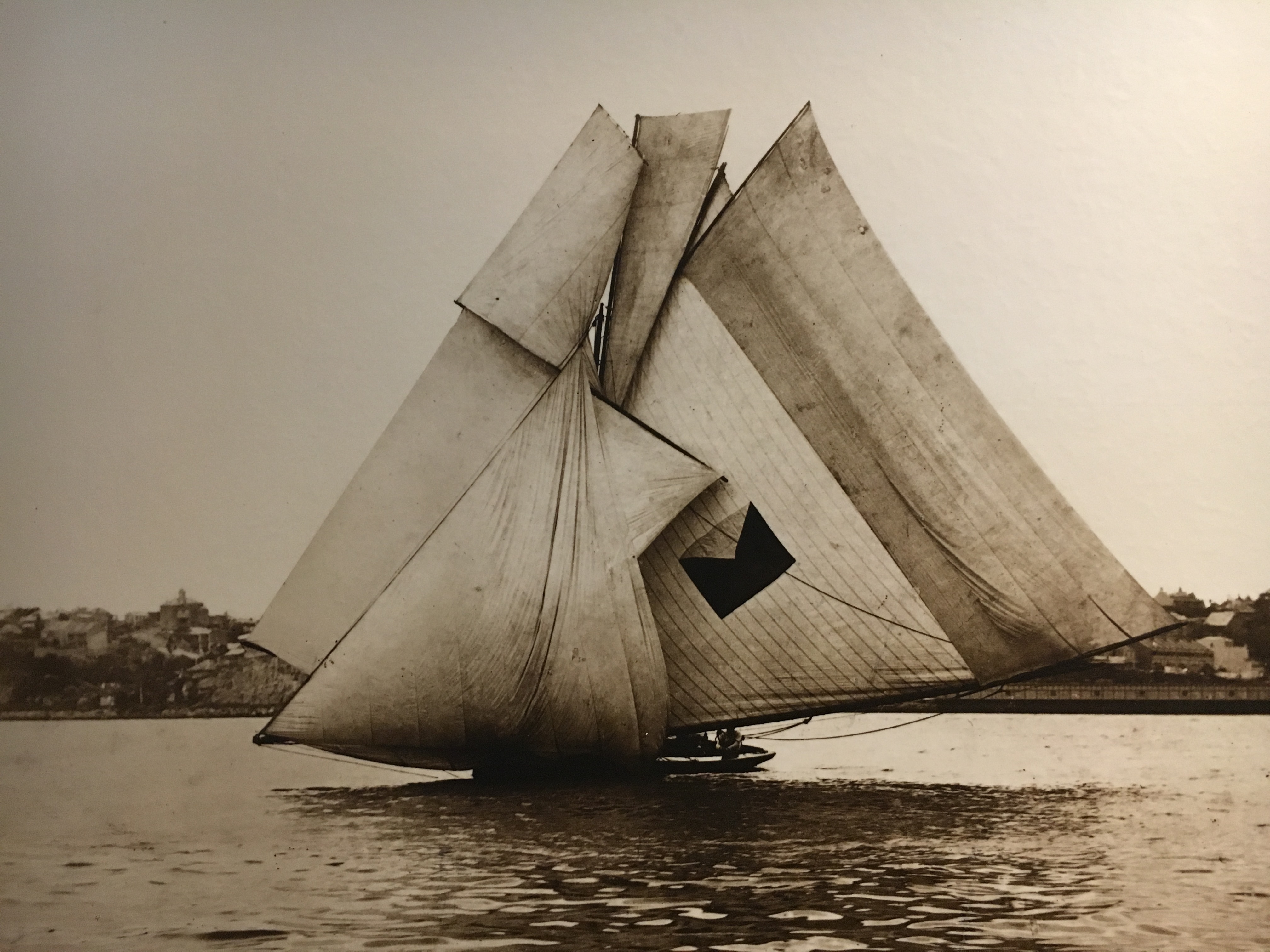Another great shot from the Hall Collection. The boat is Charlie Dunn’s 18-footer Acme, which raced with this insignia (yellow and black squares) from 1906 to 1915 and in 1917-18, when it was sold and renamed Florrie. The insignia was changed to a two-tone triangle. In 1922 Florrie’s colours changed over to Florrie II, and the boat resumed the name Acme and took up the original colours. This image appears to show the yellow and black squares badly sewn over the triangle, so it is likely to be taken early in the 1922-23 season. There are other indications that the crew is not used to the boat as well: the tops’l club is upset because the sheet lead is wrong, and the kicker is coiled out on the pole and somebody forgot to release it when the poles went out. Lucky for them it’s a light day. And yes, at this time the kicker led to the inboard end of the first pole, not the far end, and down through the chainplates, pole end kickers did not begin to happen until the early 1930’s.
Above and below: The clarity of some of the glass negatives in the Hall Collection is amazing. This may not reproduce that well here, but on the original digitisation one can zoom in close to see many details, like these shots from the same slide of a boat that I believe to be Keriki.
************************************************************************
This shot of the Brisbane 18-footer MG III sailed by Laurie McCormack, who sent the picture to Kevin O’Keefe in 2001 and is now in the archives of the Australian Historical Sailing Skiff Association. The picture is from the early 1960’s, and shows how late some boats sailed with ringtails, even with Bermudan rigs. Laurie sailed MG I, II and III, all for an owner who apparently was shamed by this photo of patched sails appearing in the Courier Mail into buying a new spinnaker and ringtail the following week.
There was an earlier Britannia than the one we are used to seeing, this one built by Hugh Anderson in Brisbane. They travelled down to Sydney for the Intercolonial Challenge in 1897 (see The Intercolonial Challenges of the 1890's on the YARNS Page) in 1897 and were 2nd in the 18-footers' Championship race. Note that both the tops'l head spinnaker and the masthead spinnaker are attached to the spinnaker poles, the only time I've seen this recorded. also note the absence of a sail insignia. The Intercolonial Challenge was conducted by the Johnstones Bay Sailing Club which did not insist on sail insignias, unlike the Sydney Flying Squadron. Hall photo in SFS Collection.
The frd hand in an unidentified 18-footer is about to break out the spinnaker. This image has great definition for studying the details of how the spinnaker poles were rigged in the late 1930's. As well as the frd kicker led through a block near the end of the bumpkin (first used in the early 1930's) and the brace led back to the windward quarter, they are still using an inner kicker attached in the middle of the outermost of three pole sections, led down to the chainplates. There is no topping lift, only the luff of the spinnaker supports the pole. The halyard is led aft to the tuck (transom) as a backstay. At first I assumed the spinnaker was stropped with wool as was usual, but it has been pointed out to me that it looks rolled, and in this case rolled really tightly which is perhaps why it is resisting breaking out as the sheet is being pulled down with enough force to lift the poles by binding across the sail. Words are probably being said from aft! Though the water doesn't seem to show it they are rigged down for a fresh breeze, and the rest of the crew of probably 7 or 8 are all out of shot in the back half of the boat to keep the bow out of the water with the frd hand frd of the mast. Photo from the John Stanley Collection.
Lan Taylor's* 18-footer Quibree* about 1912-14 with their spinnaker set from the top of the yard of he tops'l which was common at the time, but the force is skewing the tops'l. The spinnaker has a small curved yard at its head which was also common on the early spinnakers. The same spinnaker can be seen in the first photo of Quibree in the alphabetical listing under 18-FOOTERS. It was already old-fashioned by 1912-14, most sailmakers realised a triangular headed spinnaker would still work. The working jib is lashed down to the bumpkin and the balloon jib is set as well as the spinnaker. Note that there is no kicker from the pole end down to the front of the bumpkin, a feature that only came in during the early 1930's. They usually did have a kicker attached to the inboard end of the outer pole section led down to the chainplates and sometimes back over the pole and down again. The belief was that the skying spinnaker lifted the bow which it did. Eighteens had a tendency to bury the bow downwind. However I suspect that photographers tended to concentrate on snapping the spinnaker when it was high because it looks more spectacular. Photo courtesy of the Johnson family.
Even the 10-footers carried watersails. Postcard in AHSSA collection.
Eighteen footer Ariel, built by Joe Donnelly* in 1894 (his first 18 footer) which makes her one of the earliest of the class that was emerging in the early 1890's. She was built for owner Mr C.H.Gorrick from Lake Macquarie, north of Sydney and did most of her racing in general fleets there, but regularly came down to Sydney for special events,and in most of those events was steered by the legendary boatbuilder and skipper George Ellis (see under Boatbuilders). This photo appears to be from the Balmain Regatta, which Ariel is reported as entering in 1894, 1895 and 1899. A light westerly is blowing her along the Balmain/Birchgrove shore under squares'l and a balloon jib (not clearly seen but the working jib is down, stowed on the bumpkin, bowsprit for anybody other than skiffies), so this has to be 1894. Notice on the squares'l yard is a stopped raffee. See Aztec under alphabetical list of Eighteen Footers and the photo below of 22 footer Vigilant* for shots of a raffee, a sort of square tops'l set from the jackyard of the jackyard tops'l and sheeted on the windward half of the squares'l yard. When we started the Australian Historical Sailing Skiff Association in the early 1990's there were blokes still alive who had sailed gaff-rigged open boats, but nobody left who had set a squares'l or raffee. So its interesting to see that they sometimes sent them up in stops. Whether they went up with the squares'l yard or could be hoisted independently is something we have to puzzle over. Both squares'l and raffees were discontinued when spinnakers came into use in the late 1890's. Incidentally Ariel won the race, the first of many in a shortish career which seems to end in 1899.
The 22 footer Vigilant,* built in 1896 by Billy Golding in Balmain for a "syndicate of 20 young fellows". On a very light day she is carrying a squares'l with raffee above set from the jackyard tops'l, a ringtail set from the peak of the gaff and the end of the boom extending the sail area of the main out from the leech, and a very large balloon jib set from the end of the bumpkin (the spar that others might call a bowsprit). For the full story of these sails and why we call it a bumpkin and not a bowsprit, you'll have to read the Open Boat book.
